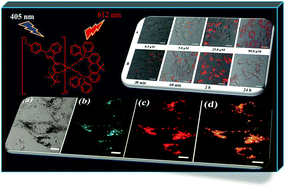A lysosome targetable luminescent bioprobe based on a europium β-diketonate complex for cellular imaging applications†
Abstract
Herein, we report a novel lysosome targetable luminescent bioprobe derived from a europium coordination compound, namely Eu(pfphOCH3IN)3(DDXPO) 4 [where HpfphOCH3IN = 4,4,5,5,5-pentafluoro-3-hydroxy-1-(1-(4-methoxyphenyl)-1H-indol-3-yl)pent-2-en-1-one and DDXPO = 4,5-bis(diphenylphosphino)-9,9-dimethylxanthene oxide]. Notably, the newly designed europium complex exhibits significant quantum yield (Φoverall = 25 ± 3%) and 5D0 excited state lifetime (τ = 398 ± 3 μs) values under physiological pH (7.2) conditions when excited at 405 nm. Hence the developed europium complex has been evaluated for live cell imaging applications using mouse pre-adipocyte cell lines (3T3L1). Colocalization studies of the designed bio-probe with commercial Lysosome-GFP in 3T3L1 cells demonstrated the specific localization of the probe in the lysosome with a high colocalization coefficient (A = 0.83). Most importantly, the developed bioprobe exhibits good cell permeability, photostability and non-cytotoxicity.


 Please wait while we load your content...
Please wait while we load your content...